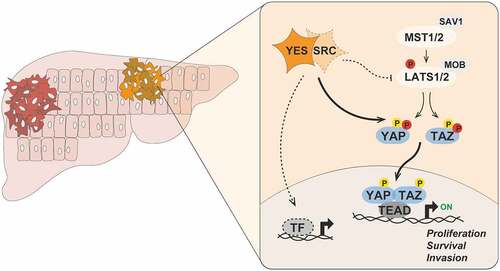Figures & data
Figure 1. Aberrant YES signaling promotes hepatic oncogenesis. Upon activation in hepatocytes, the SRC-family kinase YES directly phosphorylates YAP (Tyr391 and Tyr407) and TAZ (Tyr305) on tyrosine residues, thereby promoting their nuclear accumulation and transcriptional activity. SRC may also redundantly regulate the activity of YAP and TAZ in certain cellular contexts. In parallel, YES and SRC can phosphorylate and inhibit the activity of LATS1/2 kinases to antagonize the negative regulation of YAP/TAZ by the Hippo pathway. Activated YAP and TAZ then associate with TEAD, and possibly other, family of transcription factors to activate gene expression programs controlling proliferation, survival and invasion of transformed hepatocytes. It is likely that YES signaling regulates the activity of other transcription factors and effectors that contribute to liver tumorigenesis. Phosphorylated tyrosine and serine/threonine residues are depicted in yellow and red, respectively. MST, mammalian STE20-like protein kinase; SAV1, Salvador family WW domain containing protein 1; LATS, large tumor suppressor kinase; MOB, MOB kinase activator; YAP, Yes-associated protein 1; TAZ, WW domain-containing transcription regulator protein 1; TEAD, TEA domain; TF, transcription factor.

